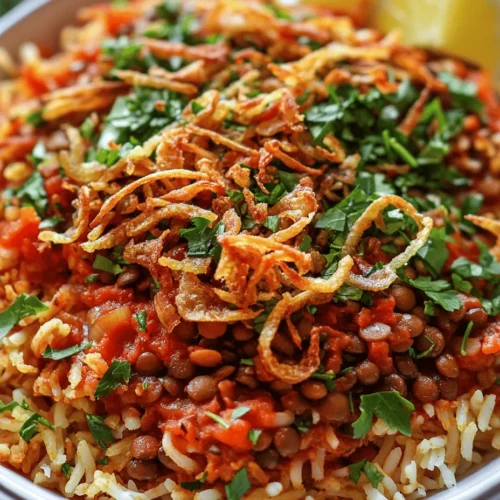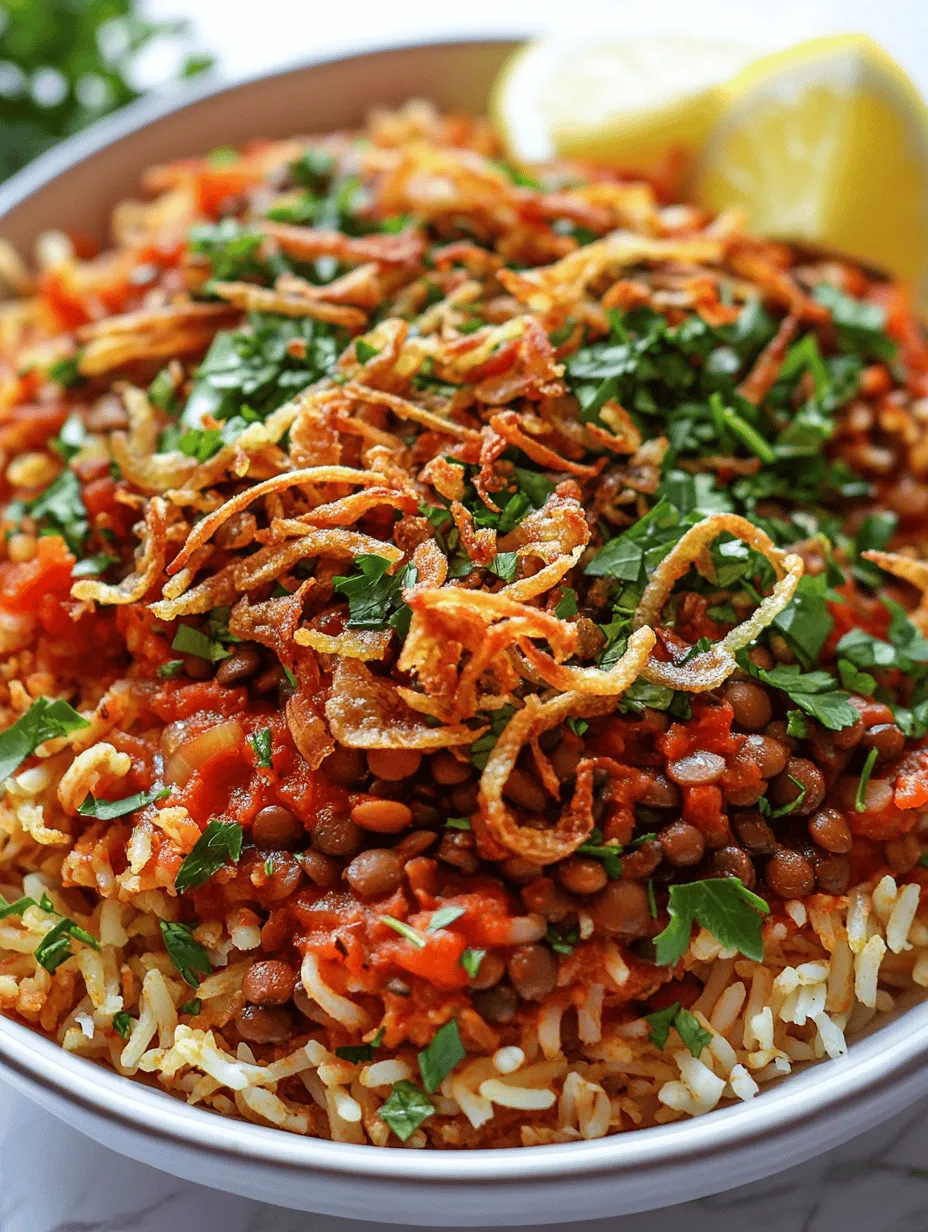Introduction
Koshari is a beloved staple of Egyptian cuisine, renowned not only for its rich flavors but also for its cultural significance. This hearty dish embodies the essence of Egyptian comfort food, often found in bustling street stalls and family kitchens alike. As one of Egypt’s national dishes, Koshari brings together a delightful medley of ingredients, creating a symphony of flavors that has made it a favorite across the globe.
The dish traditionally combines rice, lentils, and pasta, topped with a spicy tomato sauce and crowned with crispy fried onions. Its humble origins stem from the need for affordable and nutritious meals, making Koshari a symbol of Egypt’s culinary heritage. Beyond its delicious taste, Koshari represents a sense of community and togetherness, as families gather to enjoy this filling meal.
In this article, we will explore the components of Koshari, delve into the nutritional benefits of its ingredients, and guide you through the first steps of preparing this delightful dish.
Understanding the Ingredients
Brown Lentils: Nutritional Benefits and Role in Koshari
A key component of Koshari, brown lentils are not only integral to the dish’s flavor profile but also pack a significant nutritional punch. Rich in protein, fiber, and essential vitamins, lentils are an excellent choice for vegetarian and vegan diets, making Koshari a wholesome meal for all.
Brown lentils have a slightly earthy flavor and a firm texture that holds up well during cooking, contributing to the overall heartiness of the dish. They are also a great source of iron, which is essential for maintaining energy levels and overall health. When cooked properly, these lentils add a depth of flavor and a satisfying chewiness to Koshari, balancing the softer textures of rice and pasta.
To prepare the lentils for Koshari, it’s important to rinse them thoroughly to remove any debris. Cooking them until they are tender but not mushy will ensure they maintain their shape and contribute to the dish’s texture.
Rice: Choosing the Right Type
In Koshari, rice serves as a crucial foundation, providing a fluffy and filling base for the dish. For the best results, long-grain rice is recommended, as it tends to cook up light and separate rather than sticky. Varieties such as basmati or jasmine rice are excellent choices due to their aromatic qualities and ability to absorb flavors.
From a nutritional standpoint, rice is a great source of carbohydrates, providing the energy needed to fuel your day. It also serves as a blank canvas, soaking up the flavors of the accompanying sauces and spices.
When preparing the rice for Koshari, it’s essential to rinse it under cold water until the water runs clear. This step removes excess starch, ensuring that the rice cooks evenly and achieves the desired fluffy consistency. The right cooking technique will yield perfectly cooked rice that complements the other ingredients beautifully.
Pasta: The Essential Component
Pasta may seem like an unusual addition to a rice and lentil dish, but in Koshari, it plays a vital role in creating a delightful texture and heartiness. Typically, short pasta varieties such as ditalini or elbow macaroni are used, adding a unique dimension to the dish.
Pasta brings its own set of carbohydrates and a comforting familiarity to Koshari, making it a filling meal. The combination of pasta with lentils and rice ensures that each bite is packed with varying textures, from the softness of the rice to the chewiness of the lentils and the slight firmness of the pasta.
When cooking the pasta, be mindful not to overcook it, as it should hold its shape and provide a pleasant contrast to the other components of Koshari. A quick boil followed by a rinse in cold water will help prevent the pasta from becoming too soft.
Onions: The Flavor Base
Fried onions are perhaps one of the most beloved elements of Koshari, adding both flavor and texture to this layered dish. The sweet, caramelized notes of fried onions elevate Koshari, providing a crunchy contrast to the softer elements.
To achieve the perfect crispy onions, slice them thinly and cook them slowly in hot oil. Patience is key; allowing the onions to fry at a medium temperature ensures they become golden brown without burning. Once fried, these onions can be generously sprinkled on top of the Koshari, creating a deliciously aromatic experience with every bite.
Tomato Sauce and Spices: Creating the Flavorful Sauce
The finishing touch to Koshari is its signature tomato sauce, which ties all the ingredients together. This sauce is typically made with fresh tomatoes or canned tomato puree, simmered to create a rich, tangy base that perfectly complements the other components of the dish.
To enhance the sauce’s flavor, a blend of spices is essential. Common spices used in Koshari include cumin, coriander, and garlic powder. Cumin adds a warm, earthy note, while coriander introduces a hint of citrusy brightness. Garlic powder not only enhances the savory aspect of the sauce but also brings a comforting aroma that is characteristic of many traditional dishes.
In addition to their flavor contributions, these spices provide various health benefits, such as anti-inflammatory properties and digestive support. Together, they create a sauce that is both flavorful and nourishing.
Step-by-Step Cooking Instructions
Cooking the Lentils
To begin your Koshari journey, start by cooking the lentils. Here’s how to prepare them for optimal flavor and texture:
1. Rinse: Measure out the brown lentils and rinse them under cold water to remove any dust or debris. This step is crucial for cleanliness and will help the lentils cook evenly.
2. Soak (optional): For a quicker cooking time, consider soaking the lentils in water for about 30 minutes. This will help them soften and reduce cooking time.
3. Cook: In a medium saucepan, add the rinsed lentils and cover them with water, ensuring there’s about an inch of water above the lentils. Bring the water to a boil, then reduce the heat to a simmer.
4. Check for doneness: Cook the lentils for approximately 20-25 minutes, or until they are tender but not mushy. You want them to hold their shape, so be sure to taste them as they cook.
5. Drain and set aside: Once cooked, drain any excess water and set the lentils aside. They will become a wonderful addition to your Koshari, providing both nutrition and a hearty texture.
Preparing the Rice
While the lentils are cooking, it’s time to prepare the rice. Here’s a simple guide to achieving perfectly cooked rice for your Koshari:
1. Rinse: Measure out the long-grain rice and rinse it under cold water until the water runs clear. This step removes excess starch and will help the rice remain fluffy.
2. Cook: In a large pot, combine the rinsed rice with water. The typical ratio is 1 part rice to 2 parts water, but check the package instructions for specific recommendations.
3. Bring to a boil: Place the pot over medium-high heat and bring the water to a boil. Once boiling, reduce the heat to low and cover the pot with a lid.
4. Simmer: Allow the rice to simmer gently for about 15-20 minutes, or until the water is fully absorbed and the rice is tender. Avoid lifting the lid too often, as this will release steam and affect the cooking process.
5. Fluff and set aside: Once the rice is cooked, remove it from the heat and let it sit covered for an additional 5 minutes. Fluff the rice with a fork to separate the grains, then set it aside to cool slightly before assembling your Koshari.
With the lentils and rice prepared, you’re well on your way to creating a delicious Koshari Delight. Stay tuned for the next steps, where we will explore how to cook the pasta, fry the onions, and prepare the flavorful tomato sauce that ties this traditional dish together.

Cooking the Pasta
Cooking the pasta correctly is crucial to achieving the perfect texture for your Koshari. The pasta should be cooked al dente, which ensures it holds its shape and doesn’t become mushy when combined with the other ingredients. Here’s a step-by-step guide to cooking your pasta to the right consistency:
1. Choose Your Pasta: Traditionally, Koshari uses short pasta shapes like macaroni or small shells. You can also use spaghetti or linguine if you prefer a different texture.
2. Boil Water: Fill a large pot with water, adding a generous amount of salt (about 1 tablespoon per 4 quarts of water). Bring the water to a rolling boil.
3. Add the Pasta: Once the water is boiling, add your pasta. Stir occasionally to prevent sticking.
4. Cooking Time: Check the package instructions for the recommended cooking time. Start checking the pasta about 2 minutes before the minimum time. You want it to be firm to the bite (al dente).
5. Drain and Rinse: Once the pasta is cooked to your liking, drain it in a colander. Rinse it under cold water to stop the cooking process and prevent it from sticking together. Set aside.
Frying the Onions
The crispy fried onions are a key component of Koshari, adding a delicious crunch and enhancing the overall flavor. Here are some techniques to achieve perfectly crispy onions:
1. Slice the Onions: Thinly slice large onions. Aim for even thickness to ensure they cook uniformly.
2. Heat the Oil: In a deep frying pan or skillet, heat vegetable oil over medium-high heat. The oil should be hot enough that a slice of onion sizzles upon contact.
3. Fry in Batches: Add the sliced onions in batches to avoid overcrowding the pan. Fry until they turn golden brown, stirring occasionally for even cooking.
4. Drain the Onions: Once crispy, remove the onions with a slotted spoon and transfer them to a plate lined with paper towels to absorb excess oil. Season with a pinch of salt while still hot.
Making the Tomato Sauce
The tomato sauce for Koshari brings all the flavors together, creating a rich and savory backdrop for the dish. Follow these instructions to create a delicious sauce:
1. Sauté Garlic and Spices: In a saucepan, heat a tablespoon of oil over medium heat. Add minced garlic (3-4 cloves) and sauté until fragrant but not browned. This should take about 30 seconds.
2. Add Tomato Paste: Stir in a tablespoon of tomato paste, mixing it well with the garlic and allowing it to cook for an additional minute.
3. Combine with Tomatoes: Add crushed tomatoes (about 2 cups) along with salt, pepper, and a teaspoon of cumin. You can also add a pinch of cayenne pepper for a bit of heat, if desired.
4. Simmer the Sauce: Bring the mixture to a simmer, then reduce the heat and let it gently cook for 15-20 minutes. The sauce should thicken slightly and develop rich flavors. Adjust seasoning to taste.
Assembling the Koshari
Now that you have all the components prepared, it’s time to assemble your Koshari for serving. This layering technique not only enhances the flavors but also makes for a visually appealing dish.
1. Layer the Rice: Start with a base of rice (about 1 cup per serving) in a large bowl or plate.
2. Add the Pasta: Spoon the cooked pasta over the rice, distributing it evenly.
3. Incorporate the Lentils: Next, add a layer of cooked lentils on top of the pasta. This adds texture and protein to the dish.
4. Top with Sauce: Generously pour the tomato sauce over the entire layered mixture, ensuring it seeps down into the layers.
5. Finish with Onions: Finally, top the Koshari with the crispy fried onions for that signature crunch.
6. Garnish: Optionally, you can garnish with chopped parsley or cilantro for a pop of color and added freshness.
Serving Suggestions
Koshari can be served warm or at room temperature, making it a versatile dish for any occasion. Here are some ideas for garnishing and serving Koshari attractively:
– Accompaniments: Serve with a side of Egyptian-style salad made of diced tomatoes, cucumbers, and a simple lemon vinaigrette to balance the richness of the dish.
– Hot Sauce: Offer a spicy sauce on the side, such as dukkah sauce or harissa, for those who enjoy extra heat.
– Presentation: Serve Koshari in individual bowls for a more refined presentation, or place it in a large serving dish for communal dining.
– Breads: Pair with warm pita or Egyptian flatbread to scoop up the Koshari, enhancing the dining experience.
Cultural Context of Koshari
Koshari in Egyptian Cuisine
Koshari is often regarded as Egypt’s national dish, with a rich history that reflects the country’s diverse influences. It originated in the 19th century, likely brought to Egypt by Italian and French immigrants who introduced pasta to the local cuisine. Over time, Koshari evolved into a distinct dish that combines various elements of Egyptian culinary traditions.
Regional variations exist, with some areas using different types of lentils or spices. Nonetheless, the core components—rice, pasta, lentils, and tomato sauce—remain consistent. Personal adaptations are common, and many families have their unique twist, making Koshari not just a meal but a cherished family recipe passed down through generations.
Koshari as Comfort Food
In Egyptian culture, Koshari holds significant sentimental value. It is a dish that evokes memories of family gatherings, celebrations, and street food vendors. The sharing of meals is a vital aspect of Egyptian hospitality, and Koshari is often prepared for large gatherings, symbolizing community and togetherness.
Its affordability and hearty nature make it a staple in many households. Whether enjoyed at a bustling street stand or lovingly prepared at home, Koshari represents comfort and satisfaction, embodying the warmth of Egyptian cuisine.
Nutritional Analysis of Koshari
Balanced Meal Components
Koshari is not only delicious but also offers a well-rounded nutritional profile. The dish combines carbohydrates from the rice and pasta, protein from the lentils, and essential vitamins from the tomato sauce and spices. This balance makes it a wholesome meal option.
– Macronutrients: On average, a serving of Koshari contains around 400-500 calories, comprising approximately 60% carbohydrates, 20% protein, and 20% fat. The lentils contribute valuable fiber, aiding digestion and promoting satiety.
Vegetarian and Vegan Appeal
One of the standout features of Koshari is its suitability for vegetarian and vegan diets. With no animal products involved, it serves as a filling option for those seeking plant-based meals. The combination of lentils and rice provides a complete protein source, making it a nutritious choice for anyone looking to incorporate more vegetarian dishes into their diet.
Conclusion
Making Koshari at home is an enriching experience that allows you to connect with the flavors and traditions of Egyptian cuisine. The joy of layering rice, pasta, lentils, and rich tomato sauce is not only satisfying but also a celebration of culinary creativity.
By trying this recipe, you not only indulge in a delicious meal but also embrace a piece of Egyptian culture that emphasizes family, sharing, and comfort. Koshari’s versatility means it can be adapted to fit various dietary preferences while remaining true to its roots. So gather your ingredients, invite family or friends, and enjoy creating this delightful dish that promises to bring warmth and joy to your table.



